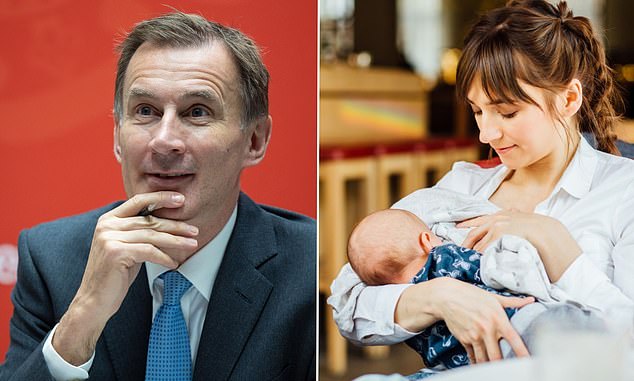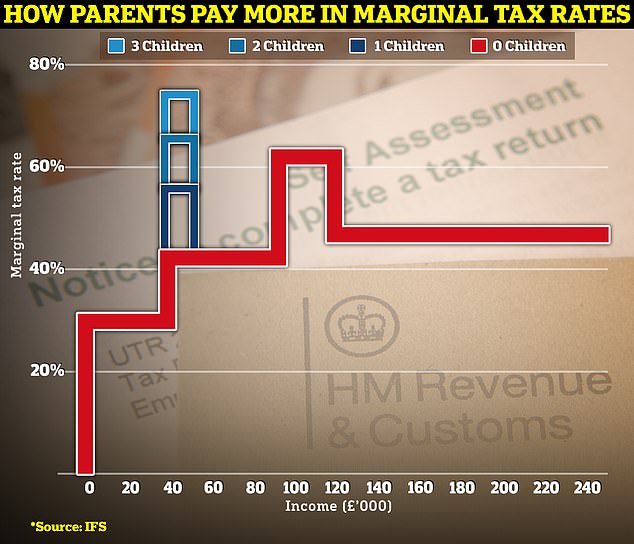The Chancellor raised the threshold at which working parents pay high-income child benefit to £60,000 in the Spring Budget.
The government currently claws back child benefit for households where the highest earner has an income over £50,000, and withdraws it entirely when they earn over £60,000.
This will change from April, when the threshold will rise to £60,000, while the threshold at which you withdraw will rise to £80,000.
Then, by 2026, the system will shift to assessing household income in an attempt to mitigate the controversial tax trap.
But critics of the high income charge on child benefits, which creates high marginal tax rates for parents, were left disappointed after it was not removed entirely. We explain what you need to know.

The Chancellor has raised the threshold at which working parents start paying child benefit
The High Income Child Benefit (HICBC) payment, introduced a decade ago, has been criticized for placing an additional burden on working parents.
Today, Jeremy Hunt said it is “not fair” that a household with two parents earning £49,000 each receives full child benefit, while a household earning less overall but with one parent earning £50,000 will have some or all of the benefit withdrawn.
That system was announced by his Conservative predecessor, George Osborne, in 2010.
In his budget statement, Hunt said the system required “significant reform” and that he would consult on the possibility of moving to a system based on household income rather than individual income by 2026.
In the immediate future, the threshold for HICBC will increase from £50,000 to £60,000.
The Government says it will stop paying the tax entirely for 170,000 families, and estimates that almost half a million families will have an extra £1,260 in 2024/5.
What is the child benefit high income charge?
If you currently earn less than £50,000 a year, you can claim full child benefit, which is currently £24 a week and £15.90 for additional children.
However, the high income charge for child benefit means that if you or your partner has an individual income of more than £50,000, you will have to pay back some or all of it.
Unlike other taxes, it is based on total individual income rather than household income, so the highest earner in a couple is responsible for paying the fee.
When it was introduced in January 2013, the threshold was set at £50,000 adjusted net income, which is a person’s total taxable income before personal allowances.
The more you earn above £50,000, the more you will pay and this will decrease until you reach £60,000, when you will have to pay back 100 per cent of the charge. This means that you will not receive any child benefits.


Tax traps: The graph above shows marginal tax rates for income tax and national insurance on the red line, rising to 62% between £100,000 and £125,000 due to the removal of the personal allowance. The blue lines show the effect of removing child benefit between £50,000 and £60,000.
Why collecting child benefit has been controversial
The removal of child benefit has created higher marginal tax rates for affected parents.
Officially, the income tax and national insurance rate for someone earning £50,300 is 42 per cent, but the removal of child benefit means the marginal tax rate (the rate on the next pound earned) for a parent with one child it is 54 percent. while for a father with two children it is 63 percent.
This figure increases to 71 percent for parents with three children.
Hunt’s decision to increase the threshold from £50,000 to £60,000 means there will be fewer parents forced to pay the charge.
However, if the £50,000 threshold for HICBC had increased with inflation since it was announced, it would be £67,000, and if it had increased with average salaries it would be £71,774, according to Hargreaves Lansdown.
Alice Haine, of Bestinvest by Evelyn Partners, said: “The increase in the threshold at which HICBC applies to £60,000 from April will be welcomed by parents across the country, along with the longer-term plan to move it to a home-based system. system by April 2026.
“But the injustice will not completely end until the benefit is based on the overall household income and not the highest earner, something that will not happen for more than a year.”
Some links in this article may be affiliate links. If you click on them, we may earn a small commission. That helps us fund This Is Money and keep it free to use. We do not write articles to promote products. We do not allow any commercial relationship to affect our editorial independence.
